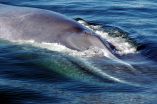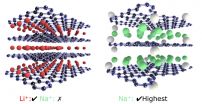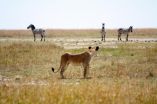Study on world's biggest animal finds more than 1 population in the southeastern Pacific
Researchers find that there are probably 2 separate populations of blue whales in the southeastern Pacific
2014-12-18
(Press-News.org) Scientists from WCS (Wildlife Conservation Society), the Universidad Austral de Chile, the Blue Whale Center, the American Museum of Natural History (AMNH), NOAA, and other organizations are examining molecular clues to answer a big question: how many types of blue whales exist in the waters of the southeastern Pacific?
The answer seems to be two distinct populations, according to a genetic study comparing the blue whales off the southern coast of Chile with those swimming in the waters of Antarctica and other nearby regions. One of the populations could be made up of pygmy-type blue whales, a subspecies slightly smaller than the Antarctic blue whale. The findings could help wildlife managers devise more effective conservation plans for this endangered species.
The study appears in the online edition of the journal Molecular Ecology. To access the study, click here: http://onlinelibrary.wiley.com/doi/10.1111/mec.12990/abstract
Reaching nearly 100 feet in length, the blue whale is thought to be the largest animal that ever existed, even larger than the biggest known dinosaurs. Blue whales were nearly hunted to extinction by commercial whaling fleets in the 20th Century before the species was granted international protection in 1966.
Although whaling records dating back to the 1960s indicate that both Antarctic and pygmy-type blue whales utilized Chilean waters, it wasn't until 2004--when a blue whale feeding and nursing ground was discovered in the protected bays of southern Chile--that scientists began to question whether multiple populations of blue whales currently utilized the southeastern Pacific. A previous study had even recognized the existence of an as-of-yet unnamed subspecies of blue whale based on size differences in animals in the southeastern Pacific. At the time, however, it was unknown how closely related the whales on this Chilean feeding ground were to those in other areas, and thus what this discovery might mean in terms of the recovery of the animals in the Southern Hemisphere.
"The most effective way to protect the region's blue whales depends on a better understanding of how blue whales in the waters of Chile interact with other populations of the same species, as well as knowing which areas are used for activities such as feeding and breeding to facilitate future designation of MPA network," said Dr. Juan Pablo Torres-Florez, researcher for the Universidad Austral de Chile and lead author of the study.
"Molecular methods give us the means for uncovering the hidden relationships of blue whales in southeastern Pacific, as well as finding regions of importance to the species," said Dr. Howard Rosenbaum, one of the senior authors of the paper and Director of WCS's Ocean Giants Program.
In order to investigate the genetic identity of blue whales in the coastal waters of southern Chile with respect to blue whales in other areas, the research team sequenced the DNA of 60 animals using skin samples collected from living animals with non-lethal biopsy darts fired from crossbows between 2003 and 2009. The analysis enabled the team to identify 52 individuals based on specific regions of both nuclear and mitochondrial DNA.
The samples from these whales were then compared with existing datasets from whales in the eastern tropical Pacific (where southern Chile blue whales are thought to breed), northern coastal Chile, and Antarctica. The research team found that blue whales in southern Chile are similar in genetic makeup to whales in the eastern tropical Pacific and northern Chile. Whales in Antarctica were deemed to be more distantly related, indicating the region may have two distinct populations or types of blue whales, an important consideration for any plan to protect a wide-ranging marine mammal species in coastal and international waters.
"Our study gives us crucial insights into the population structure of blue whales in the waters of Chile and will serve as an important stepping stone for further research," added Rosenbaum. "The long-term goal of such work would be a network of marine protected areas designed to save the world's largest animal."
The first stepping stone was already been achieved earlier this year with the declaration of Tic Toc Marine Protected Area in the Gulf of Corcovado, Chile. "It's been 10 years since we made the initial discovery of this magnificent blue whale feeding ground with the aid of the WCS and other institutions," said Dr. Rodrigo Hucke-Gaete, principal investigator and professor at Universidad Austral de Chile, as well as president of the Blue Whale Center. He added that "building the puzzle through the aid of scientific evidence has been exciting and has taken time, but is providing robust information to aid in the recovery of this wonderful and still endangered species."
INFORMATION:
The authors of the study titled "Blue whale population structure along the eastern south Pacific ocean: evidence of more than one population" are: J.P. Torres-Florez of the Universidad Austral de Chile and the Blue Whale Center; Rodrigo Hucke-Gaete of the Universidad Austral de Chile and the Blue Whale Center; R. Leduc of the Southwest Fisheries Science Center, National Marine Fisheries Service; A. Lang of the Southwest Fisheries Science Center, National Marine Fisheries Service ; B. Taylor of Southwest Fisheries Science Center, National Marine Fisheries Service; L.E. Pimper the Universidad de Buenos Aires; L. Bedriñana-Romano of the Blue Whale Center; Howard Rosenbaum of the Wildlife Conservation Society and the American Museum of Natural History; and C.C. Figueroa of the Universidad de Talca.
[Attachments] See images for this press release:


ELSE PRESS RELEASES FROM THIS DATE:
2014-12-18
By 2050, a majority of U.S. coastal areas are likely to be threatened by 30 or more days of flooding each year due to dramatically accelerating impacts from sea level rise, according to a new NOAA study, published today in the American Geophysical Union's online peer-reviewed journal Earth's Future.
The findings appear in the paper From the Extreme to the Mean: Acceleration and Tipping Points for Coastal Inundation due to Sea Level Rise, and follows the earlier study, Sea Level Rise and Nuisance Flood Frequency Changes around the United States, by the report's co-author, ...
2014-12-18
MANHATTAN, KANSAS -- A Kansas State University engineering team has discovered some of graphene oxide's important properties that can improve sodium- and lithium-ion flexible batteries.
Gurpreet Singh, assistant professor of mechanical and nuclear engineering, and Lamuel David, doctoral student in mechanical engineering, India, published their findings in the Journal of Physical Chemistry in the article "Reduced graphene oxide paper electrode: Opposing effect of thermal annealing on Li and Na cyclability."
Graphene oxide is an insulating and defective version of graphene ...
2014-12-18
Many genetic mutations in visual pigments, spread over millions of years, were required for humans to evolve from a primitive mammal with a dim, shadowy view of the world into a greater ape able to see all the colors in a rainbow.
Now, after more than two decades of painstaking research, scientists have finished a detailed and complete picture of the evolution of human color vision. PLOS Genetics is publishing the final pieces of this picture: The process for how humans switched from ultraviolet (UV) vision to violet vision, or the ability to see blue light.
"We ...
2014-12-18
Ibuprofen, a common over-the-counter drug used to relieve pain and fever, could hold the keys to a longer healthier life, according to a study by researchers at the Buck Institute for Research on Aging. Publishing in PLoS Genetics on December 18th, scientists showed that regular doses of ibuprofen extended the lifespan of yeast, worms and fruit flies.
"There is a lot to be excited about," said Brian Kennedy, PhD, CEO of the Buck Institute, who said treatments, given at doses comparable to those used in humans, extended lifespan an average of 15 percent in the model ...
2014-12-18
Many animals may have a previously under-appreciated ability to make up for lost time with more effort, according to new research publishing this week in PLOS Computational Biology.
This capability could help scientists better understand how animals make efficient decisions in changing environments -- and ultimately help ensure the survival of a species.
Researchers from Princeton University challenge the conventional view that animals face a simple trade-off between the speed and the accuracy of their decisions. Adrian de Froment, Daniel Rubenstein and Simon Levin ...
2014-12-18
Most vaccines work by inducing an immune response characterized by neutralizing antibodies against the respective pathogen. An effective HIV vaccine has remained elusive so far, but researchers have continued to make progress, often employing innovative methods. A study published on December 18th in PLOS Pathogens reports that a combination of antibodies from llamas can neutralize (destroy) a wide range of circulating HIV viruses.
After initial disappointment that HIV vaccine candidates were unable to elicit neutralizing antibodies, researchers found that some HIV-infected ...
2014-12-18
COLLEGE STATION -- A common over-the-counter drug that tackles pain and fever may also hold keys to a longer, healthier life, according to a Texas A&M AgriLife Research scientist.
Regular doses of ibuprofen extended the lifespan of multiple species, according to research published in the journal Public Library of Science-Genetics.
"We first used baker's yeast, which is an established aging model, and noticed that the yeast treated with ibuprofen lived longer," said Dr. Michael Polymenis, an AgriLife Research biochemist in College Station. "Then we tried the same process ...
2014-12-18
This news release is available in Japanese, French, Spanish and Chinese on EurekAlert! Chinese. The Rosetta spacecraft caught up with the comet known as 67P/Churyumov-Gerasimenko beyond Mars this August, and its preliminary results--along with the studies it will allow in the near-future--top this year's list of the most important scientific breakthroughs, according to the editors of Science.
This annual list of groundbreaking scientific achievements, selected by Science and its international nonprofit publisher, AAAS, also includes groundbreaking advances in medicine, ...
2014-12-18
Research led by the Teichmann group on the Wellcome Genome Campus has identified a fundamental mechanism for controlling protein function. Published in the journal Science, the discovery has wide-ranging implications for biotechnology and medicine.
The shape of a protein determines its function, for example whether it is able to interact with another protein or with a drug. But a protein's shape is not constant - it may change in response to different conditions, or simply as a matter of course.
Understanding how this process works is key to figuring out how to manipulate ...
2014-12-18
In the decade since the genome was sequenced in 2003, scientists and doctors have struggled to answer an all-consuming question: Which DNA mutations cause disease?
A new computational technique developed at the University of Toronto may now be able to tell us.
A Canadian research team led by professor Brendan Frey has developed the first method for 'ranking' genetic mutations based on how living cells 'read' DNA, revealing how likely any given alteration is to cause disease. They used their method to discover unexpected genetic determinants of autism, hereditary cancers ...
LAST 30 PRESS RELEASES:
[Press-News.org] Study on world's biggest animal finds more than 1 population in the southeastern Pacific
Researchers find that there are probably 2 separate populations of blue whales in the southeastern Pacific






